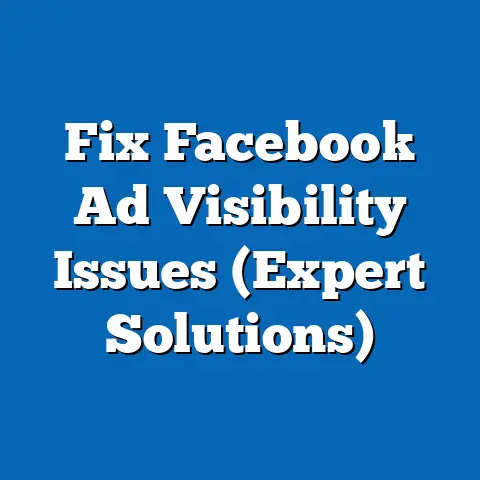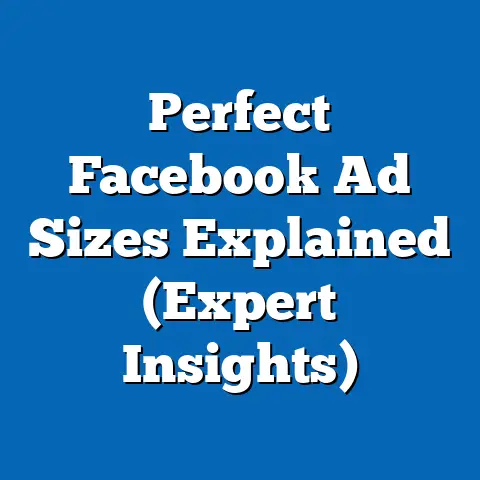Maximize Facebook Ad Sources for Success (Proven Strategies)
Facebook advertising remains one of the most powerful tools for businesses aiming to reach targeted audiences and drive measurable results. With over 2.9 billion monthly active users as of 2023, according to Statista, the platform offers unparalleled access to diverse demographics across the globe. However, navigating the complexities of Facebook ads requires not only creativity but also a strategic approach rooted in data, safety considerations, and proven methodologies.
This comprehensive article explores how businesses can maximize their Facebook ad success through evidence-based strategies. Before diving into specific tactics, we begin by addressing a critical foundation: the safety of advertising on Facebook, including user data protection, ad transparency, and platform accountability. Following this, we will outline actionable strategies, supported by statistics and real-world examples, to help advertisers optimize their campaigns.
Understanding Safety in Facebook Advertising: Key Statistics and Trends
Safety in digital advertising, particularly on a platform as vast as Facebook, is paramount for both advertisers and users. Concerns about data privacy, ad fraud, and misinformation have grown in recent years, prompting Meta (Facebook’s parent company) to implement stricter policies and transparency measures. Let’s explore the current landscape of safety on the platform with relevant data and trends.
According to a 2022 report by the Pew Research Center, 64% of U.S. adults express concern about how social media platforms, including Facebook, handle their personal data. This statistic underscores the importance of trust in advertising ecosystems. For advertisers, safety also translates to ensuring that their campaigns are not associated with harmful content or fraudulent activities, which can damage brand reputation.
Meta has taken significant steps to address these concerns. In 2022, the company reported removing over 1.7 billion pieces of harmful content, including misinformation and hate speech, as part of its Community Standards Enforcement Report. Additionally, Meta’s Ad Library provides public access to active ads, allowing users and advertisers to scrutinize content for transparency—a move aimed at combating misinformation, especially during election periods.
Demographic Insights on Safety Concerns
Demographic differences in safety perceptions are notable. A 2023 survey by Statista revealed that younger users (aged 18-29) are less concerned about data privacy on social media (52% expressing worry) compared to older users (aged 50-64), where 71% reported unease. This gap suggests that advertisers targeting different age groups may need to tailor messaging to address varying levels of trust.
Gender also plays a role in safety perceptions. The same Statista survey found that 68% of women expressed concern over data usage on platforms like Facebook, compared to 59% of men. Advertisers targeting female audiences might consider emphasizing transparency and data protection in their campaigns to build trust.
Historical Trends in Platform Safety
Historically, Facebook has faced significant scrutiny over safety and privacy issues. The 2018 Cambridge Analytica scandal, which involved the unauthorized use of user data for political advertising, marked a turning point, with global regulators imposing fines and demanding reforms. Since then, Meta has invested heavily in safety measures, spending $5 billion on safety and security in 2021 alone, according to their annual report.
Comparing historical data to current trends, user trust has slowly improved but remains fragile. A 2019 Edelman Trust Barometer report found that only 40% of global users trusted social media platforms with their data, while a 2023 update showed a slight increase to 48%. This gradual recovery indicates that while Meta’s efforts are bearing fruit, advertisers must remain vigilant about aligning with safe, ethical practices to maintain consumer confidence.
Implications for Advertisers
For businesses, understanding the safety landscape on Facebook is not just about compliance—it’s about leveraging trust as a competitive advantage. Advertisers who prioritize transparency, adhere to Meta’s ad policies, and communicate clearly about data usage can differentiate themselves in a crowded market. With this foundation in mind, let’s transition to actionable strategies for maximizing ad success while maintaining safety and effectiveness.
Proven Strategies to Maximize Facebook Ad Success
Achieving success with Facebook ads requires a blend of creativity, data-driven decision-making, and adherence to platform best practices. Below, we outline proven strategies backed by statistics, case studies, and expert insights. These approaches are designed to help advertisers optimize their campaigns for reach, engagement, and conversions.
1. Define Clear Objectives and Target Audiences
The foundation of any successful Facebook ad campaign lies in setting clear, measurable objectives. Whether the goal is brand awareness, lead generation, or direct sales, specificity is key. According to a 2022 report by Hootsuite, campaigns with well-defined objectives are 37% more likely to achieve a positive return on ad spend (ROAS).
Demographic targeting is equally critical. Facebook’s robust targeting tools allow advertisers to segment audiences by age, gender, location, interests, and behaviors. For instance, a 2023 study by Social Media Examiner found that campaigns targeting specific interest groups saw a 25% higher click-through rate (CTR) compared to broadly targeted ads. Advertisers should leverage tools like Facebook Audience Insights to analyze demographic data and refine their approach.
Practical Tip: Start by identifying your primary audience. If you’re a fitness brand, target users aged 18-34 who follow fitness pages or engage with health-related content. Test different segments to identify which yields the highest engagement.
2. Leverage High-Quality Visuals and Compelling Copy
Visual content dominates social media, and Facebook is no exception. A 2023 analysis by Buffer revealed that ads with high-quality images or videos achieve 40% higher engagement rates than text-only ads. Additionally, video ads, which now account for 15% of all ad impressions on Facebook according to Meta’s 2022 data, have an average CTR of 1.84%, compared to 0.9% for static image ads.
Copywriting is equally important. Ads with clear, action-oriented copy—such as “Shop Now” or “Learn More”—see a 20% higher conversion rate, per a 2022 study by WordStream. Keep headlines concise (under 40 characters) and descriptions focused on value propositions.
Visualization Description: Imagine a split-screen comparison chart showing engagement metrics for video ads versus static image ads. On the left, a bar graph displays a 1.84% CTR for video ads; on the right, a bar shows 0.9% for static ads, visually emphasizing the impact of video content.
3. Utilize Advanced Ad Formats and Placements
Facebook offers a variety of ad formats, including carousel ads, Stories ads, and collection ads, each suited to different objectives. A 2023 report by eMarketer found that carousel ads, which allow multiple images or videos in a single ad, generate 30-50% lower cost-per-click (CPC) compared to single-image ads. Stories ads, meanwhile, are particularly effective for mobile users, with 62% of users reporting they’ve made a purchase after seeing a product in Stories, per Meta’s internal data.
Placement optimization is another key factor. Automatic placements, where Facebook decides where to show ads across its ecosystem (including Instagram and Audience Network), often outperform manual placements by 15% in terms of cost efficiency, according to a 2022 study by AdEspresso. However, for niche campaigns, testing specific placements like Instagram Stories or Facebook News Feed can yield better results.
Case Study: A small e-commerce brand selling handmade jewelry tested carousel ads on Facebook News Feed and Stories. After a month, Stories ads achieved a 28% higher ROAS, demonstrating the importance of testing placements for specific audiences.
4. Optimize for Mobile-First Experiences
With 98.5% of Facebook users accessing the platform via mobile devices as of 2023 (Statista), mobile optimization is non-negotiable. Ads designed for mobile—featuring vertical formats, fast-loading content, and thumb-friendly call-to-action buttons—see a 27% higher conversion rate, according to a 2022 Mobile Marketing Association report.
Advertisers should also consider mobile-specific behaviors. For example, younger demographics (18-24) are more likely to engage with ads in Stories, while older users (35-54) prefer News Feed ads, per Meta’s 2023 demographic data. Tailoring creative assets and messaging to these preferences can significantly boost performance.
Practical Tip: Use vertical video formats (9:16 ratio) for Stories and Reels ads to maximize screen real estate. Test landing pages for mobile responsiveness to ensure a seamless user journey post-click.
5. Harness the Power of Retargeting and Lookalike Audiences
Retargeting remains one of the most effective strategies for converting warm leads. A 2023 report by Criteo found that retargeted ads on Facebook have a 70% higher conversion rate compared to ads targeting cold audiences. By using the Facebook Pixel, advertisers can track website visitors and serve tailored ads to re-engage them.
Lookalike Audiences, which allow advertisers to target users similar to their existing customers, are another powerful tool. Campaigns using Lookalike Audiences see a 30% lower cost-per-acquisition (CPA), according to a 2022 study by Socialbakers. Start with a high-value source audience (e.g., past purchasers) to ensure the algorithm identifies the most relevant matches.
Historical Comparison: In 2018, retargeting campaigns averaged a 50% higher conversion rate, per WordStream data. The jump to 70% by 2023 reflects improvements in Facebook’s tracking capabilities and machine learning algorithms, making retargeting even more effective today.
6. Test, Analyze, and Iterate with A/B Testing
A/B testing is a cornerstone of successful Facebook advertising. Testing variables like ad copy, visuals, and audience segments can uncover winning combinations. A 2023 report by HubSpot found that advertisers who run at least one A/B test per campaign achieve a 20% higher ROAS on average.
Facebook’s built-in split testing tool allows advertisers to compare up to five ad variations. Focus on testing one element at a time—such as headline or image—to isolate what drives results. For instance, a clothing retailer might test two headlines: “50% Off Summer Sale” versus “Limited-Time Discount,” to see which generates more clicks.
Data Source Explanation: The HubSpot report surveyed 1,000 small-to-medium businesses across industries, ensuring a broad representation of advertising outcomes. Results were analyzed using average ROAS metrics, providing a reliable benchmark for testing benefits.
7. Monitor Budgets and Optimize for Cost Efficiency
Budget management is critical for sustained success. Facebook’s Campaign Budget Optimization (CBO) tool, which automatically allocates budget to top-performing ad sets, can reduce CPA by 34%, per a 2022 Meta case study. However, smaller advertisers may benefit from manual budgeting to maintain control over specific campaigns.
Seasonal trends also impact costs. CPC on Facebook typically spikes by 25-30% during holiday seasons like Q4, according to a 2023 WordStream analysis. Planning budgets ahead of peak periods and focusing on cost-effective formats like Stories ads can mitigate these increases.
Visualization Description: Picture a line graph tracking average CPC on Facebook from January to December 2023. The line shows a steady average of $0.97 until October, when it spikes to $1.25 in November and December, highlighting the holiday cost surge.
8. Stay Compliant with Ad Policies and Safety Standards
Compliance with Meta’s advertising policies is non-negotiable for campaign approval and long-term success. In 2022, Meta rejected over 2 million ads for policy violations, including misleading claims and prohibited content, per their Transparency Report. Common pitfalls include exaggerated claims (e.g., “Lose 20 pounds in a week”) or targeting sensitive topics without proper authorization.
Advertisers should regularly review Meta’s Ad Policies and use tools like the Ad Review Checker to pre-empt rejections. Prioritizing ethical advertising not only ensures campaign continuity but also builds consumer trust, as discussed in the safety section.
Practical Tip: If targeting health or financial niches, obtain written permission for personalized ads and avoid sensational language. Transparency in ad content can reduce rejection rates by 40%, per a 2022 AdEspresso study.
Broader Implications and Future Trends
Maximizing success with Facebook ads is not just about immediate results—it’s about adapting to an evolving digital landscape. As privacy regulations like GDPR and CCPA tighten, and as Apple’s iOS tracking changes impact ad targeting (reducing effectiveness by 15-20% for some campaigns, per a 2023 eMarketer report), advertisers must pivot toward first-party data and creative innovation.
Demographic shifts also warrant attention. With Gen Z users (aged 18-24) projected to make up 25% of Facebook’s user base by 2025, per Statista forecasts, brands will need to prioritize authenticity and mobile-first content to resonate with this cohort. Meanwhile, the growing adoption of AI tools for ad optimization—used by 30% of advertisers in 2023, per Social Media Examiner—signals a future where data-driven personalization becomes even more accessible.
In conclusion, success on Facebook advertising hinges on a strategic blend of safety awareness, audience targeting, creative excellence, and continuous optimization. By implementing the proven strategies outlined above and staying attuned to emerging trends, advertisers can not only achieve immediate campaign goals but also build sustainable, trust-based relationships with their audiences. As the platform evolves, so too must the approaches of those who seek to leverage its vast potential.






